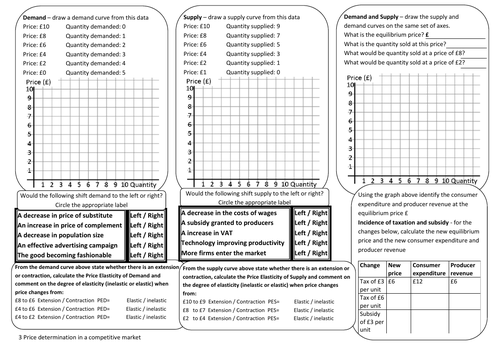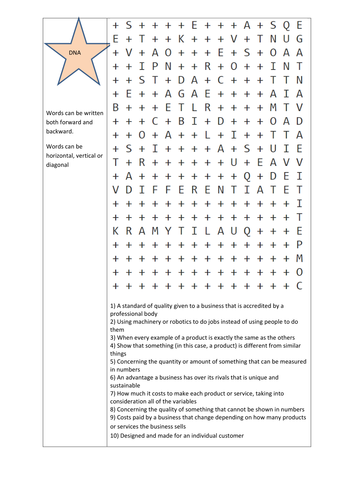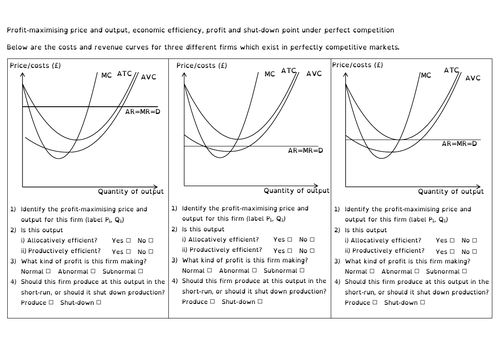155Uploads
218k+Views
225k+Downloads
All resources

Edexcel GCSE (9-1) Business exam technique 2 mark Outline questions
An activity on answering 2 mark Outline questions.
The font is OpenDyslexic - Free, OpenSource Dyslexia Typeface
http://opendyslexic.org/

AQA A-level Economics The distribution of income and wealth knowledge organiser
Knowledge organiser for the The distribution of income and wealth: poverty and inequality topic from the AQA A-level Economics. Includes a set of example answers.
Any suggestions/improvements/complaints please do comment and I will update it for future editions.

AQA A-level Economics Economic methodology and positive and normative economics
A set of work for Economic methodology and positive and normative economics. Includes a powerpoint presentation, a glossary of key words, a sorting activity, some multiple choice questions and two news articles to identify positive and normative economic statements.
Some of the text use is in OpenDyslexic font - Free, OpenSource Dyslexia Typeface
For a knowledge organiser for the whole AQA A-level Economics topic: Economic methodology and the economic problem see here

AQA A-level Economics What is Macroeconomics?
Introductory lesson on Macroeconomics.
Includes definitions that students work out deductively, a word fill on general macroeconomic objectives and a round robin activity in which students fill in their handout.

AQA A-level Economics Economic methodology and the economic problem knowledge organiser
Knowledge organiser for the Economic methodology and the economic problem topic from the AQA A-level Economics. Includes a set of example answers.
Any suggestions/improvements/complaints please do comment and I will update it for future editions.

Edexcel GCSE (9-1) Business Topic 1.5 key words wordsearch
Key words taken from Edexcel GCSE (9-1) Business textbook.
Some of the text on the presentation is in OpenDyslexic font - Free, OpenSource Dyslexia Typeface
http://opendyslexic.org/

Edexcel GCSE (9-1) Business 1.5 Understanding external influence - Technology and business worksheet
Both .pdf and .docx file formats have been included
The font is OpenDyslexic - Free, OpenSource Dyslexia Typeface
http://opendyslexic.org/

AQA A-level Economics Price determination in a competitive market knowledge organiser
Knowledge organiser for the Price determination in a competitive market topic from the AQA A-level Economics. Includes a set of example answers.
Any suggestions/improvements/complaints please do comment and I will update it for future editions.

AQA AS and Year 12 Economics Competitive and concentrated markets knowledge organiser
Knowledge organiser for the Competitive and concentrated markets topic from the AQA AS and Year 12 Economics. Includes a set of example answers.
There is a version of this with A-level Economics content which can be found here:
https://www.tes.com/teaching-resource/aqa-a-level-economics-production-costs-and-revenue-knowledge-organiser-11887669
Any suggestions/improvements/complaints please do comment and I will update it for future editions.

Edexcel GCSE (9-1) Business Topic 1.1 key words wordsearch
Key words taken from Edexcel GCSE (9-1) Business textbook.
Some of the text on the presentation is in OpenDyslexic font - Free, OpenSource Dyslexia Typeface
http://opendyslexic.org/

Areas of surplus, revenue, expenditure and deadweight loss under perfect competition versus monopoly
Activity I use with year 13 to learn about the impact of monopolies on allocative efficiency.
The answers:
Consumer surplus under perfect competition? (1+2+3)
Producer surplus under perfect competition? (4+5)
Total surplus under perfect competition? (1+2+3+4+5)
Consumer expenditure/Producer revenue under perfect competition? (4+5+6+7)
Consumer surplus under monopoly? (1)
Producer surplus under monopoly? (2+4+6)
Total surplus under monopoly? (1+2+4+6)
Consumer expenditure/Producer revenue under monopoly? (2+4+6)
Deadweight welfare loss under monopoly? (3+5)
Bonus Question: (6)
The font is OpenDyslexic - Free, OpenSource Dyslexia Typeface
http://opendyslexic.org/

Monopolistic competition: profit-maximisation, efficiency, profit and shut-down point
An exercise to identify profit-maximising price and output, economic efficiency, profit and shut-down point under monopolistisic competition.
An answer sheet is provided as well as the answers being included on the attached slideshow.
The font is OpenDyslexic - Free, OpenSource Dyslexia Typeface
http://opendyslexic.org/

Edexcel GCSE (9-1) Business Topic 1.1 revision knowledge organiser
Useful for revising Edexcel GCSE (9-1) Business topic 1.1 Enterprise and entrepreneurship. Separate suggested answers included.
Both .pdf and .doc file formats have been included
Any suggestions/improvements/complaints please do comment and I will update it for future editions.
The full set of Edexcel GCSE (9-1) Business revision knowledge organisers can be found below:
Topic 1.1 Enterprise and entrepreneurship
Topic 1.2 Spotting a business opportunity
Topic 1.3 Putting a business idea into practice
NEW Topic 1.3 Putting a business idea into practice
Topic 1.4 Making the business effective
Topic 1.5 Understanding external influences on business
Topic 2.1 Growing the business
Topic 2.2 Making marketing decisions
Topic 2.3 Making operational decisions
Topic 2.4 Making financial decisions
Topic 2.5 Making human resource decisions

Edexcel GCSE (9-1) Business Topic 2.3 key words wordsearch
Key words taken from Edexcel GCSE (9-1) Business textbook.
Some of the text on the presentation is in OpenDyslexic font - Free, OpenSource Dyslexia Typeface
http://opendyslexic.org/

A-level Economics Merit and Demerit goods revision
A4 revision worksheet on Merit and Demerit goods. Includes a second sheet with suggested answers. Both .pdf and .doc file formats have been included.
06 May 2021 Update: Now includes a slideshow explaning the answers
The font is OpenDyslexic - Free, OpenSource Dyslexia Typeface
http://opendyslexic.org/

Edexcel GCSE (9-1) Business Topic 2.2 revision knowledge organiser
Useful for revising Edexcel GCSE (9-1) Business topic 2.2 Making marketing decisions. Separate suggested answers included.
Both .pdf and .docx file formats have been included
Any suggestions/improvements/complaints please do comment and I will update it for future editions.
The full set of Edexcel GCSE (9-1) Business revision knowledge organisers can be found below:
Topic 1.1 Enterprise and entrepreneurship
Topic 1.2 Spotting a business opportunity
Topic 1.3 Putting a business idea into practice
Topic 1.4 Making the business effective
Topic 1.5 Understanding external influences on business
Topic 2.1 Growing the business
Topic 2.2 Making marketing decisions
Topic 2.3 Making operational decisions
Topic 2.4 Making financial decisions
Topic 2.5 Making human resource decisions

Edexcel GCSE (9-1) Business formulas dominoes
A set of dominoes for all of the formulas needed for Edexcel GCSE (9-1) Business. The dominoes all fit together to form a closed loop pairing descriptions with formulas. An answer table is also included.
I recommend printing the dominoes double sided onto card and then cutting each page into three horizontal strips.
Any suggestions/improvements/complaints please do comment and I will update it for future editions.
The font is OpenDyslexic - Free, OpenSource Dyslexia Typeface
http://opendyslexic.org/

Perfect competition: profit-maximisation, efficiency, profit and shut-down point
An exercise to identify profit-maximising price and output, economic efficiency, profit and shut-down point under perfect competition.
An answer sheet is provided as well as the answers being included on the attached slideshow.
The font is OpenDyslexic - Free, OpenSource Dyslexia Typeface
http://opendyslexic.org/

Microeconomics test - Demand, Supply, Price, Consumer Expenditure, and Consumer & Producer Surplus
A microeconomics test covering the topics described. A mixture of calculations, drawing curves and definitions. Mark scheme and feedback slideshow included.
The font is OpenDyslexic - Free, OpenSource Dyslexia Typeface
http://opendyslexic.org/
Updated 06/10/2017 to correct the spellings of equilibrium, response and parallel.

Guide to the new Edexcel GCSE (9-1) Business
A guide to the new Edexcel GCSE (9-1) Business. I created it to hand out at parents evening.
Font is in OpenDyslexic font - Free, OpenSource Dyslexia Typeface
Contents:
Course Code
Overview of the changes
Structure of GCSE (9-1) Business
New content
Removed content
Structure of papers and Command Words
Summary of new Command Words
-Define/Give/Identify/State 1 mark
-Complete the table 1 mark
-Calculate 2 marks
-Outline 2 marks
-Explain 3 marks
-Discuss 6 marks
-Analyse 6 marks
-Justify 9 marks
-Evaluate 12 marks
Formulae




















